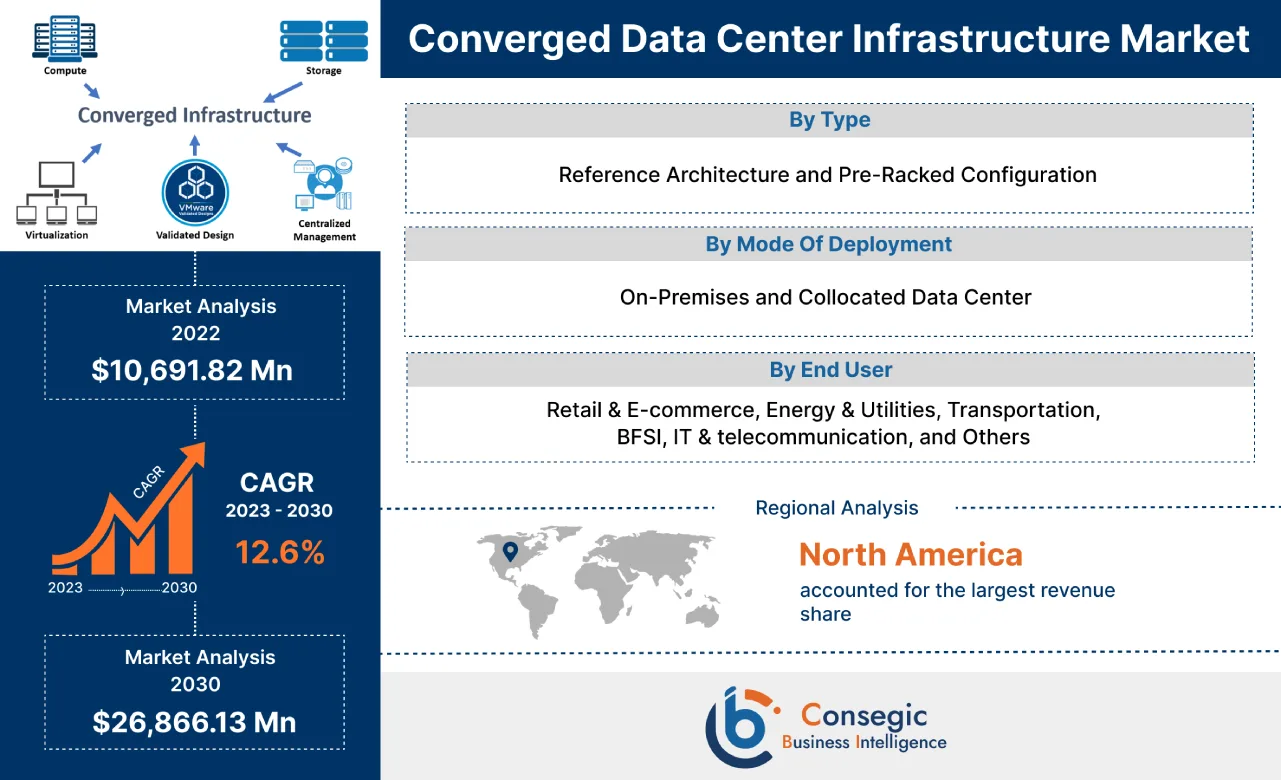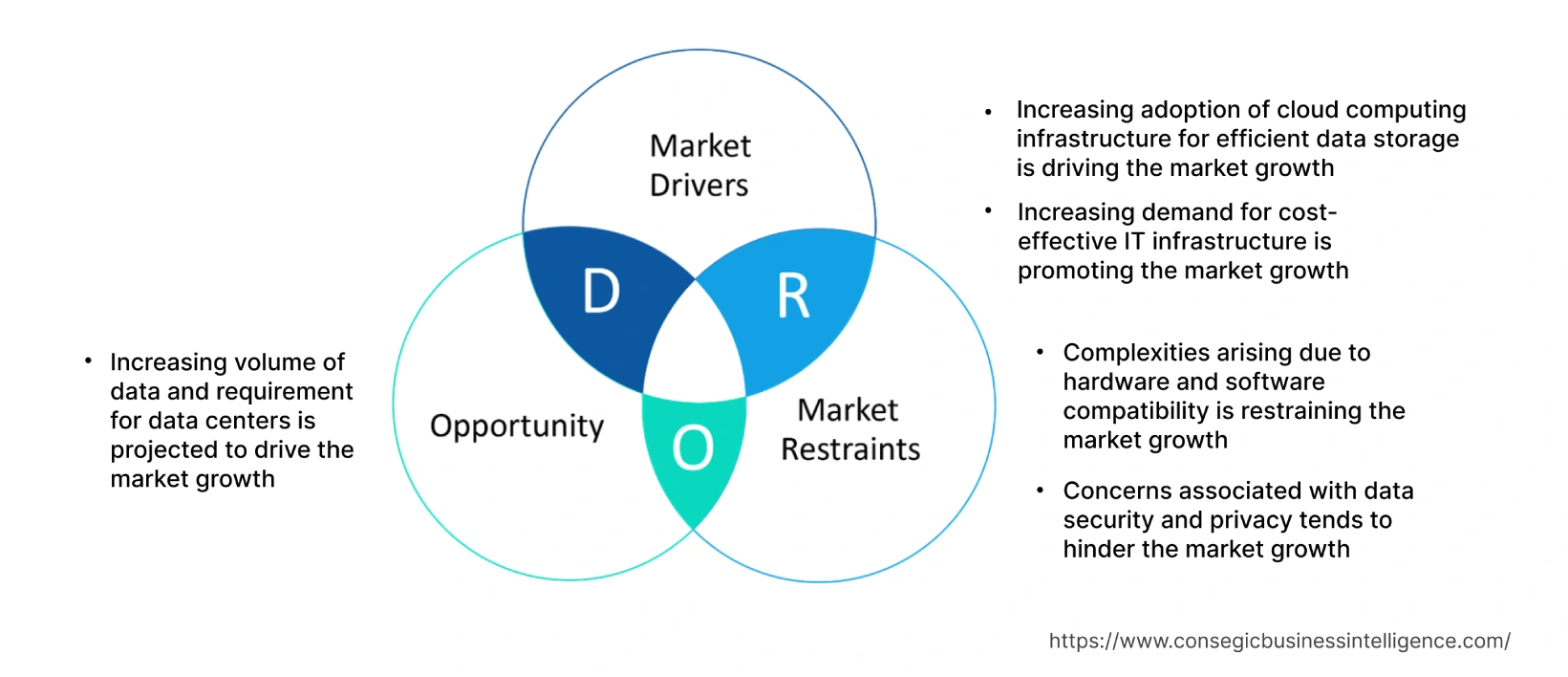- Summary
- Table Of Content
- Methodology
Converged Data Center Infrastructure Market Size :
Converged Data Center Infrastructure Market size is estimated to reach over USD 26,866.13 Million by 2030 from a value of USD 10,691.82 Million in 2022, growing at a CAGR of 12.6% from 2023 to 2030.
Converged Data Center Infrastructure Market Scope & Overview:
Converged data center infrastructure is defined as pre-set package of bundle of systems that include storage, servers, management software, and networking. In addition, converged data center infrastructure offers various organizations the chance to adopt or purchase software and hardware components from a single vendor thus reducing the complex structure of purchase. Moreover, provided package of systems are pre-tested and pre-configured depending on the growing requirements of organizations.
Furthermore, with the growing requirements of storage and computational resources has been fulfilling the market growth of converged data center infrastructure market. For instance, Lenovo is offering Converged HX Series, capable of integrating software that allows businesses to operate in a more convenient manner. Thus, growing requirements for simple IT infrastructure for data centers is proliferating the demand for converged data center infrastructure market.
Converged Data Center Infrastructure Market Insights :
Key Drivers :
Increasing adoption of cloud computing infrastructure for efficient data storage is driving the market growth
Cloud computing technology has revolutionized the pattern of data storage and has been benefiting the organizations to store large volume of data in a cost effective way. It is estimated that by mid-2023, more than 60% of the world's corporate data is stored in the cloud. The aforementioned industry is estimated to garner around USD 178 billion revenue annually.
Moreover, the key factors attributed towards the growth of cloud computing data storage is reduced infrastructure cost incurred due to installation of hardware at on-premises locations. Moreover, key features promoting the demand for cloud computing include data accessibility, usability, security, automation, and others is promoting its market growth. Furthermore, with the growth of cloud computing, the requirement for hardware and software has risen which is ultimately seeking the demand for a properly converged data center infrastructure which is driving its market growth. For instance, Syndrome Technologies Pvt. Ltd. located in Mumbai, India is offering data center infrastructure for data storage. The facility offering includes support, integration with any cloud, low cost, among others tends to drive the market growth for converged data center infrastructure market.
Increasing demand for cost-effective IT infrastructure is promoting the market growth
IT infrastructure includes variable cost depending upon the requirements of an organization. The on-premises costing includes networking equipment, servers, UPS systems, hard drives, and others. However, cloud computing offers low cost offerings by reducing the installation of aforementioned equipment at the on-premises location. Moreover, the growing requirement of organizations to store large volume of data and its security in a cost effective way is garnering the demand for cost efficient IT infrastructure which is being fulfilled by converged data center infrastructure.
Moreover, variable costing includes energy consumed by the system, for instance, on average a server rack consumes 7kW of energy, in addition with the energy required to cool the equipment. Furthermore, on average, only 30% of the total capacity of the data center is in use, however, consumer need to incur the lease cost for the entire floor. Accordingly, in order to avoid additional cost for the IT infrastructure, organizations are entirely moving forward to acquire converged data center infrastructure which is ultimately driving its market growth.
Key Restraints :
Complexities arising due to hardware and software compatibility is restraining the market growth
Converged data center often offers pre-packed configuration of hardware and software which tends to be incompatible with the existing software system of the organization. Compatibility is termed as the ability of hardware and software to function together without any alteration. Moreover, compatibility is also referred as interoperability between two products which tends to be a difficult task for the organization planning to move or integrate with a different cloud platform. Thus, owing to aforementioned factors including differentiation in version of hardware, software and mismatch with the cloud infrastructure is restraining the market growth.
Concerns associated with data security and privacy tends to hinder the market growth
Cloud storage facilitate exchange of large volume of organizational data with the service provider. Confidentiality remains a major concern with the user along with the service provider. The personal data stored in the servers are subjected to theft owing to lack of security features being offered by the service provider thus causing a sever loss to the user. Moreover, factors including data loss due to external environmental conditions including extreme weather conditions, fire, and others hinder the market growth of cloud based data centers.
For instance, IBM is offering cloud based security services to its users, namely X-Force, to avoid any data loss. Thus, unwanted theft of data and its potential loss tends to reduce the growth of the market.
Future Opportunities :
Increasing volume of data and requirement for data centers is projected to drive the market growth
Data is a growing requirement for every organization for better understanding of market. According to Exploding Topic, approximately 328.77 million terabytes of data is generated every day. Meanwhile, 120 zettabytes of data are generated by 2023 and is anticipated to increase by 150% to 181 zettabytes by 2025. Moreover, US has more than 2,700 data centers, followed by Germany (487), UK (456), China (443), and Canada (328). Therefore, owing to growing data requirement by individuals and organizations tends to drive the market growth during the forecast period.
Converged Data Center Infrastructure Market Report Insights :
| Report Attributes | Report Details |
| Study Timeline | 2017-2030 |
| Market Size in 2030 | USD 26,866.13 Million |
| CAGR (2023-2030) | 12.6% |
| By Type | Reference Architecture and Pre-Racked Configuration |
| By Mode of Deployment | On-Premises and Collocated Data Center |
| By End-User | Retail & E-commerce, Energy & Utilities, Transportation, BFSI, IT & telecommunication, and Others |
| By Region | North America, Europe, Asia-Pacific, Latin America, and Middle East & Africa |
| Key Players | Nutanix, Dell EMC, Cisco Systems, Hewlett Packard Enterprise, Hitachi Energy, IBM Corporation, NetApp Inc., Oracle Corporation, Microsoft, VMware, Lenovo, Riverbed Technology, Fujitsu, and StarWind |
Converged Data Center Infrastructure Market Segmental Analysis :
By Type :
Based on the type, the market is bifurcated into reference architecture and pre-racked configuration. The reference architecture segment accounted for the largest revenue share in the year 2022. Reference architecture is set of guidelines provided by the vendor to the user for building a converged data center infrastructure. Aforementioned architecture is generated on the basis of industry best practices coupled with best technologies. Moreover, reference architecture is easy to adopt by the organization owing to its understandable format and availability of best solutions. The key features attributed to the growth of the structure are owing to its design and implementation robustness that allow the management to work effectively. For instance, Hewlett Packard Enterprise is offering Hewlett Packard Enterprise Information Library containing Reference Architecture Portfolio for its users.
The pre-racked configuration segment is anticipated to register fastest CAGR growth during the forecast period. Pre-racked configuration includes pre-configured or pre-integrated converged infrastructure solutions. The user seeks directly from the vendor who provides all necessary component including storage, networking, servers, and others for infrastructure development. The key advantages including simplicity, support, rapid deployment, and others have been driving the market growth of the segment. Moreover, rise in dependency and reliability in cloud infrastructure will promote the market during the forecast period.
By Mode of Deployment :
Based on the mode of deployment, the market is bifurcated into reference On-premises and collocated data center. The collocated data center segment accounted for the largest revenue share in the year 2022. Moreover, the segment is anticipated to growth during the forecast period owing to its popularity among all segment of businesses. Owing to the growing requirement for secured and reliable IT infrastructure, most of the organizations are seeking interest in adopting collocated data center. Furthermore, cost efficiency, which tends to be a major factor for organizations, is driving the market growth of this segment and further tends to grow during the forecast period.
By End-User :
Based on the end-user, the market is segregated into Retail & E-commerce, Energy & Utilities, Transportation, BFSI, IT & telecommunication, and Others. The IT & telecommunication segment accounted for the largest revenue share of 31.4% in the year 2022. The segment is also expected to grow with the fastest CAGR during the forecast period. Owing to the increasing demand for modern technology and communication infrastructure, the IT and telecommunication sector is widely adopting converged data centers for efficient functioning. Among few of the factors including data storage and processing demand; flexibility and scalability; network and connectivity, and others is promoting the market growth of the segment.
For instance, according to CRISIL, the capacity of data centers in India will get doubled in between 1700 and 1800 MW. Moreover, during the period in between 2023 and 2025, India will add more than 900 MW capacity. Since, India is one of the major hubs to the IT industry, the growth of converged data center is expected to fuel the market growth during the forecast period.
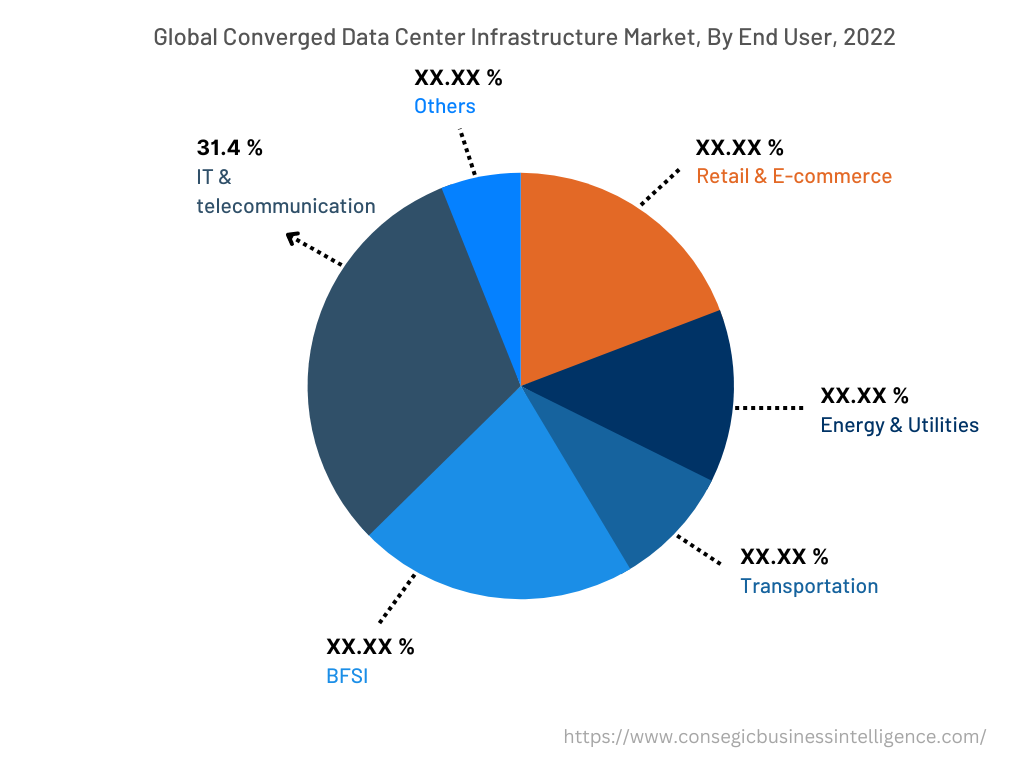
By Region :
The regional segment includes North America, Europe, Asia Pacific, Middle East and Africa, and Latin America.
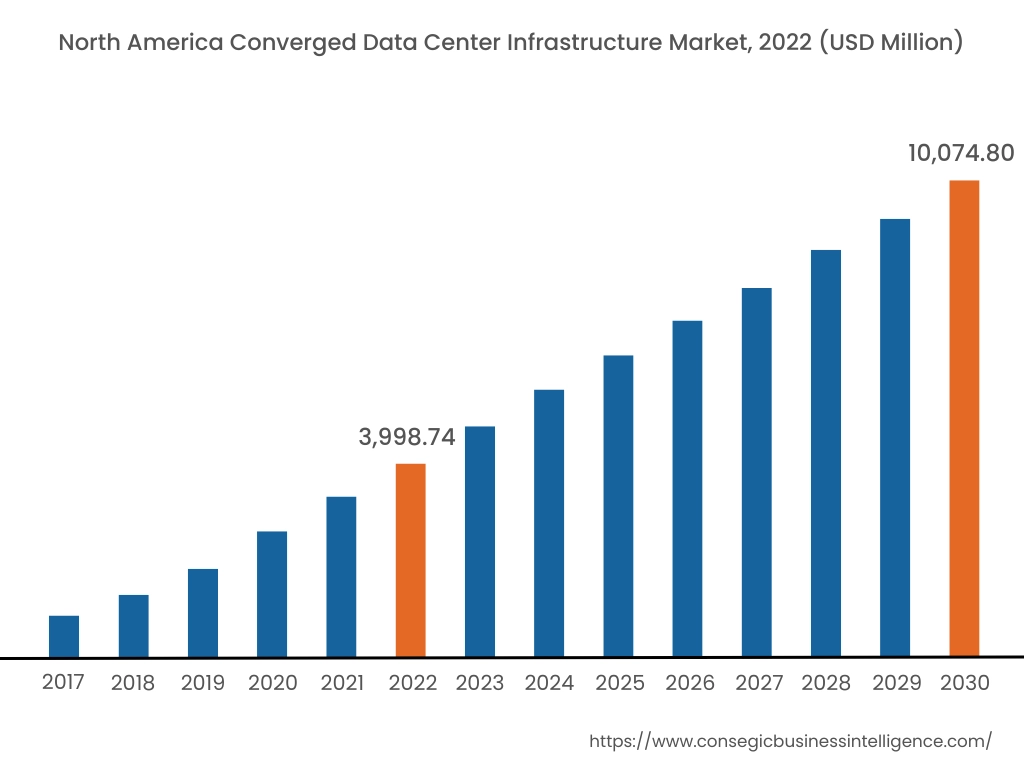
North America accounted for the largest revenue share of USD 3,998.74 Million in 2022 and is expected to reach USD 10,074.80 Million by 2030, registering a CAGR of 12.7% during the forecast period. In addition, in the region, the U.S. accounted for the maximum revenue share of 65.45% in the same year. The adoption of converged data center infrastructure in the North American region is primarily driven by technological advancement in the region including cloud computing, internet, digital services, and others. Owing to the faster adoption of technology, business across the regions is increasingly seeking for data centers to support the growing digital economy which has driven the market growth for converged data centers.
Asia-Pacific is expected to register fastest CAGR growth of 12.9% during the forecast period. The rising pace of industrialization and development is creating lucrative opportunities for market growth in the region. Moreover, factors including the growth of multiple industries including IT and telecommunication, BFSI, retail and others are seeking the demand for data centers in the region. Furthermore, the growth of the media and entertainment industry coupled with IT will propel the demand for data centers. For instance, according to Invest India, the media & entertainment industry in India projected to grow by 10.5% annually and reach USD 35.4 billion by 2025. Therefore, the growing media & entertainment sector is projected to drive the utilization of converged data center infrastructure by entertainment companies to reach a larger range of target audiences with its marketing content, thereby, boosting the market growth in the Asia-Pacific region during the forecast period.
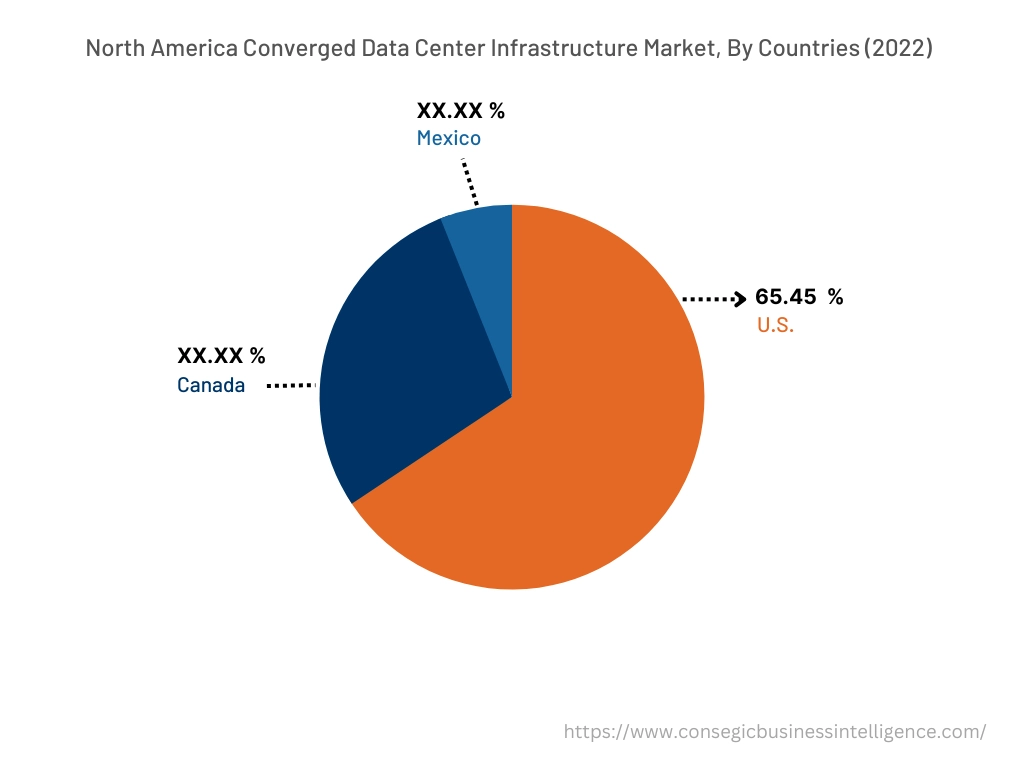
Top Key Players & Market Share Insights :
The Converged Data Center Infrastructure market is highly competitive with major players providing converged data center infrastructure to the national and international markets. Key players are adopting several strategies in research and development (R&D), product innovation, and application launches to hold a strong position in converged data center infrastructure market. Key players in the Converged Data Center Infrastructure market include-
- Cisco Systems
- Hewlett Packard Enterprise
- Hitachi Energy
- IBM Corporation
- NetApp Inc.
- Oracle Corporation
- Microsoft
Recent Industry Developments :
- In December 2021, Dell EMC, introduced new Converged Management Software with CloudIQ for VxBlock Systems, which was previously offered by VxBlock 1000.
- In March 2022, NetApp and Cisco extended their partnership by announcing the extension of FlexPod XCS converged infrastructure into the hybrid cloud.
Key Questions Answered in the Report
What is Converged Data Center Infrastructure? +
Converged Data Center Infrastructure is defined as pre-set package of bundle of systems that include storage, servers, management software, and networking.
What specific segmentation details are covered in the Converged Data Center Infrastructure report, and how is the dominating segment impacting the market growth? +
For instance, by type segment has witnessed reference architecture as the dominating segment in the year 2022, owing to flexibility being offered by the structure to the users.
What specific segmentation details are covered in the Converged Data Center Infrastructure market report, and how is the fastest segment anticipated to impact the market growth? +
For instance, by end-user segment has witnessed IT & telecommunication as the fastest-growing segment during the forecast period due to the rising adoption of data center by IT based companies for targeting potential market segments and customers, increasing brand awareness, and attracting potential customers.
Which region/country is anticipated to witness the highest CAGR during the forecast period, 2023-2030? +
Asia-Pacific is anticipated to register fastest CAGR growth of 12.9% during the forecast period due to rapid pace of industrialization and growth of multiple industries including IT and telecommunication, retail & e-commerce, BFSI, media & entertainment, and others.
